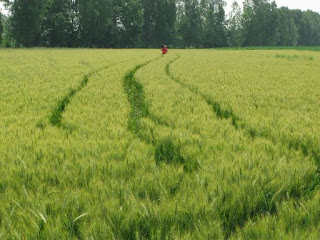La redazione di Top Secret (Rete 4) ha chiesto al CICAP di tracciarne uno davanti alle telecamere, in pieno giorno e senza alcun segreto, per spiegare al pubblico le tecniche costruttive. Il servizio andrà in onda nella puntata dedicata agli UFO, mercoledì 2 luglio alle 21.10.Essendo andata in onda la trasmissione, mi permetto di includere nel post altri dettagli dell'evento.
Per cominciare ecco il disegno realizzato per la trasmissione in un campo di grano di Mairano (BS):

Insieme a
Marco Morocutti e
Nicolas D'Amore abbiamo realizzato questa stella a 5 punte, l'
1 Giugno 2008.
Qui si possono vedere le tramlines da cui normalmente i circlemakers accedono all'interno del campo senza lasciare tracce:

Uno sguardo prima di cominciare:

Tutte le linee di costruzione vengono realizzate con i piedi, utilizzando il metro a nastro per tenere la giusta distanza dall'uomo che sta al centro:

Nicolas in uno dei punti chiave marcati con la bandierina:

Fatte le linee di costruzione si procede all'appiattimento delle aree, è la fase meno
intelligente del disegno, un po' come il gioco
Che cosa apparirà? della
Settimana Enigmistica in cui si devono annerire gli spazi segnati con il puntino:

In realtà questa fase è comunque abbastanza complessa:

La parte centrale è completata:

Un abbellimento:



Appiattimento del primo petalo:



Ciuffo centrale lasciato volutamente eretto:

Nicolas all'appiattimento con la tavola:



Un po' di riposo:

Riposo anche per Marco che malgrado non si veda nelle foto (perché è l'autore degli scatti!) ha dato il suo valido contributo:

Due tavole, una bandierina e un dettaglio della formazione:

Domande e risposte finali:

Dettaglio di un petalo:

Panoramica della formazione:

Ed ecco due riprese dall'alto della formazione completata:


Il disegno è stato realizzato in circa
due ore, ma non avevamo pianificato alcuna ottimizzazione dei tempi.
Durante l'esecuzione ci sono state
molte interruzioni per registrare i miei commenti, dei quali solo alcuni sono poi andati in onda nel servizio. E' capitato di dover registrare anche più volte lo stesso intervento per esigenze di ripresa.
Dopo aver tracciato tutte le linee di costruzione, la parte finale di appiattimento (centro, cinque petali e corona)
avrebbe potuto essere realizzata in
parallelo dalle tre persone del team (io, Marco e Nicolas)
riducendo drasticamente l'esecuzione in termini di tempo, ma così non è stato.
Per consentire maggiore libertà di ripresa agli operatori, abbiamo appiattito le aree
una dopo l'altra, come se di fatto la squadra in questa fase fosse composta da
un'unico uomo obbligato a far tutto da solo.
Se avessimo ottimizzato il tempo al massimo, avremmo potuto realizzare la stessa formazione in
poco più di un'ora.
Alcuni dettagli della realizzazione in ordine cronologico:
- individuazione del punto centrale e relativa marcatura con bandierina numerata
- esecuzione della prima linea di costruzione con i piedi (circonferenza di raggio 12 metri)
- scelta arbitraria della prima punta della stella e relativa marcatura con bandierina numerata (gli spigoli della stella sono 5 e sono quindi disposti ai vertici di un ipotetico pentagono inscritto)
- svolgimento del metro fino a 14.10 metri e marcatura con bandierina numerata della seconda punta della stella (un uomo si è posizionato sulla prima bandierina e il secondo uomo camminando nella circonferenza tracciata prima ha individuato il punto tirando il metro a nastro svolto per 14.10 metri)
- ripetizione dell'azione precedente per altre 3 volte in modo da marcare in totale la circonferenza di raggio 12 metri con 5 bandierine posizionate tutte a circa 14.10 metri (i 5 vertici del pentagono regolare inscritto!)
- tracciatura con i piedi dell'arco di cerchio dalla bandierina 2 alla bandierina 5 con centro in corrispondenza della bandierina 1 e raggio 14.10 metri
- tracciatura con i piedi dell'arco di cerchio dalla bandierina 3 alla bandierina 1 con centro in corrispondenza della bandierina 2 e raggio 14.10 metri
- tracciatura con i piedi degli altri 3 analoghi archi di cerchio con raggio 14.10 metri
- appiattimento con la tavola della zona centrale pentagonale
- appiattimento con la tavola dei 5 petali
- tracciatura con i piedi della circonferenza di raggio 13 metri
- appiattimento con la tavola della corona circolare delimitata dalle circonferenze di raggio 12 e 13 metri
- rimozione delle 6 bandierine
E' finalmente disponibile tramite il canale YouTube del CICAP il video del servizio andato in onda:
Altro a seguire in base ad eventuali domande...
Francesco Grassi





















































